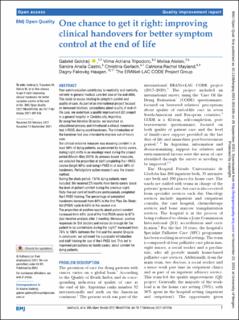| dc.contributor.author | Goldraij, Gabriel | |
| dc.contributor.author | Tripodoro, Vilma Adriana | |
| dc.contributor.author | Aloisio, Melisa | |
| dc.contributor.author | Castro, Sandra Analiá | |
| dc.contributor.author | Gerlach, Christina | |
| dc.contributor.author | Mayland, Catriona Rachel | |
| dc.contributor.author | Haugen, Dagny Renata Faksvåg | |
| dc.date.accessioned | 2021-11-29T08:31:42Z | |
| dc.date.available | 2021-11-29T08:31:42Z | |
| dc.date.created | 2021-11-08T18:15:50Z | |
| dc.date.issued | 2021 | |
| dc.identifier.issn | 2399-6641 | |
| dc.identifier.uri | https://hdl.handle.net/11250/2831806 | |
| dc.description.abstract | Poor communication contributes to morbidity and mortality, not only in general medical care but also at the end oflife. This leads to issues relating to symptom control and quality of care. As part of an international project focused on bereaved relatives’ perceptions about quality of end-of-life care, we undertook a quality improvement (QI) project in a general hospital in Córdoba city, Argentina.
By using two iterative QI cycles, we launched an educational process and introduced a clinical mnemonic tool, I-PASS, during ward handovers. The introduction of the handover tool was intended to improve out-of-hours care.
Our clinical outcome measure was ensuring comfort in at least 60% of dying patients, as perceived by family carers, during night shifts in an oncology ward during the project period (March–May 2019). As process-based measures, we selected the proportion of staff completing the I-PASS course (target 60%) and using I-PASS in at least 60% of handovers. Participatory action research was the chosen method.
During the study period, 13/16 dying patients were included. We received 23 reports from family carers about the level of patient comfort during the previous night.
Sixty-five per cent of healthcare professionals completed the I-PASS training. The percentage of completed handovers increased from 60% in the first Plan-Do-Study-Act (PDSA) cycle to 68% in the second one.
The proportion of positive reports about patient comfort increased from 63% (end of the first PDSA cycle) to 87% (last iterative analysis after 3 months). Moreover, positive responses to ‘Did doctors and nurses do enough for the patient to be comfortable during the night?’ increased from 75% to 100% between the first and the second QI cycle.
In conclusion, we achieved the successful introduction and staff training for use of the I-PASS tool. This led to improved perceptions by family carers, about comfort for dying patients. | en_US |
| dc.language.iso | eng | en_US |
| dc.publisher | BMJ | en_US |
| dc.rights | Navngivelse 4.0 Internasjonal | * |
| dc.rights.uri | http://creativecommons.org/licenses/by/4.0/deed.no | * |
| dc.title | One chance to get it right: Improving clinical handovers for better symptom control at the end of life | en_US |
| dc.type | Journal article | en_US |
| dc.type | Peer reviewed | en_US |
| dc.description.version | publishedVersion | en_US |
| dc.rights.holder | Copyright 2021 the authors | en_US |
| dc.source.articlenumber | e001436 | en_US |
| cristin.ispublished | true | |
| cristin.fulltext | original | |
| cristin.qualitycode | 1 | |
| dc.identifier.doi | 10.1136/bmjoq-2021-001436 | |
| dc.identifier.cristin | 1952497 | |
| dc.source.journal | BMJ Open Quality | en_US |
| dc.identifier.citation | BMJ Open Quality. 2021, 10 (3), e001436. | en_US |
| dc.source.volume | 10 | en_US |
| dc.source.issue | 3 | en_US |

